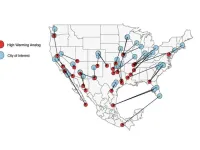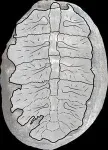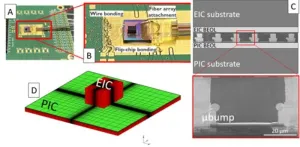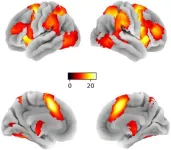(Press-News.org) UNIVERSITY PARK, Pa. – Modern-day Ciudad Mante, Mexico, could help Tampa, Florida, plan for shifting water and electricity demands due to climate change, according to an international team of researchers. Led by Renee Obringer, assistant professor of energy and mineral engineering at Penn State, the researchers used utilities data and climate analogs — contemporary cities with climates close to what other cities are predicted to experience in the future — to assess how climate change may impact residential water and electricity use across 46 cities in the United States.
Their computationally efficient model projected strong regional differences for future water and electricity demand, with some cities possibly experiencing increases in summer water and electricity demand of up to 15% and 20%, respectively, because of climate change. The researchers published their findings, which could inform how cities learn from each other in planning for climate change mitigation, in the journal One Earth.
“We’re trying to understand how future climate change scenarios might impact water-electricity demand in U.S. cities,” Obringer said. “What do these changes actually show in terms of how our bulk demand is changing, and how do we bridge the gap between research data and practice to help management agencies plan resilience to future change and better serve residents?”
According to the researchers, understanding how climate change impacts the way society uses water and electricity — from increased air conditioning use to more residential law irrigation — and how these impacts will continue to evolve is critical for building and managing resilient infrastructure systems. The issue has been a lack of available models to do such impact assessments at this regional scale, Obringer said, as most climate change models are more concerned with global trends and require significant computing power to process. Another difficulty is that water and electricity data is typically tracked and analyzed separately, with scientific papers isolating utilities in their analysis unless under specific hydropower and water-cooling scenarios.
Despite the separation, Obringer pointed out that interconnection is usually an integral, built-in part of the system, as water is frequently used for cooling in electricity generation, and electricity is used to power the systems that treat, pump and distribute water.
To train a model to predict future interactions, the researchers set out to compile past observational data on the utilities, but that proved to be the perfect microcosm of how separation creates barriers for collaboration. Obringer quickly found electricity usage data available through U.S. government agencies. However, water data is not beholden to the same regional transmission organizations, leading her to send Freedom of Act Information requests to utility companies; just over half replied.
“The isolation at the utility side is concerning, because the utility is making plans for the future understanding that climate change is likely going to shift their demand, but they might not be accounting for how it will also shift the water profile, which will, in turn, impact their demand profile,” Obringer said. “Understanding and planning for this interaction is critical for navigating climate change-induced impacts.”
Even when data is available, Obringer said, most studies utilize large-scale, global general circulation models that require sophisticated computer systems and produce technical data that is difficult for regional stakeholders to access and interpret, according to Obringer. To help address this gap, the researchers incorporated data from a previous study by Matt Fitzpatrick, associate director for research at University of Maryland Centre for Environmental Science, that analyzed how 540 U.S. cities, including State College, will look in 60 years based on several variables and then matched them to current-day regions.
With this information, in combination with observational data from the National Centers for Environmental Information’s North American Regional Reanalysis and the obtained coupled residential water and electricity demand for each city of interest, Obringer’s model could now project the water-energy nexus at an unprecedented scale.
“Nobody really knows what the temperature increasing by one and half degrees Celsius means,” Obringer said. “Instead, we can use the analogs to say the climate in New York City in 60 years will roughly look like northern Arkansas today. This provides a new methodology that allows communities to wrestle with any implications for how to manage their electricity grid or their water sources and account for what they may need in the future.”
The model projected a general increase in electricity demand for the country with slight increases in water demand, but strong variances in regional trends persisted. Some areas, like Tampa, were shown to potentially need less water because its analog of Ciudad Mante receives more annual precipitation. The western U.S., however, is projected to see increases in water consumption, potentially putting additional stress on the water system, given regional issues with drought. In Chicago, previous global general circulation model studies projected a 12% increase in electricity use, while this model’s water-energy nexus approach projected a potential 20% increase in electricity demand.
Regardless of the cause, the failure to accurately account for shifts in electricity demands can lead to disastrous results, Obringer said. In one worst-case scenario based on demand changes due to shared socioeconomic pathways, the team looked at Los Angeles County, which plans to achieve 100% renewable energy by 2050. If the predicted climate-induced increase in demand is not accounted for, the country could fall short of the projected 3.8 million megawatt hours of electricity needed. The difference would require 14,000 additional wind turbines, equivalent to approximately 20% of the current U.S. operational stock. Obringer stressed that when a city falls short of demand, not only could that lead to potential blackouts and compound social inequities, but the city may fall back on carbon-intensive electricity generation, exacerbating the climate crisis further.
“Planning for infrastructure, which usually happens 30 to 40 years in advance, requires a lot of funding and is supposed to last just as long with so much uncertainty,” Obringer said. “Simply, this model offers another methodology to help test different scenarios, see our ranges of outcomes and find the most optimal path to allow for the most flexibility going forward.”
While the study primarily focused on demand, the researchers said that others can tease out further analysis based on additional variations and scenarios specific to their region.
“If we can find a way to make those impacts more tangible — and I think this model is another tool in the toolbox that can do that — it will go a long way to improving communication, improving decision making and, hopefully, ensuring that any adaptation strategy that we have is scientifically backed and ultimately equitable and benefits the community,” Obringer said.
Also contributing were Roshanak Nateghi, associate professor, and Jessica Knee, undergrad researcher, at Purdue University; Kaveh Madani, director of the United Nations University Institute for Water, Environment and Health; and Rohini Kumar, researcher at Helmholtz Centre for Environmental Research in Leipzig, Germany.
The National Science Foundation and the National Socio-Environmental Synthesis Center supported this research.
END
Sister climate cities, utility data predict future water, electricity demands
2023-12-07
ELSE PRESS RELEASES FROM THIS DATE:
New target found for treatment of spinal muscular atrophy
2023-12-07
The lab of Yongchao C. Ma, PhD, at Stanley Manne Children’s Research Institute at Ann & Robert H. Lurie Children’s Hospital of Chicago uncovered a novel mechanism that leads to motor neuron degeneration in spinal muscular atrophy (SMA). This discovery offers a new target for treatment that overcomes important limitations of gene therapy and other current therapies for SMA.
SMA is a genetic disease that disrupts the nerve cells that control voluntary muscle movement. Symptoms of motor neuron degeneration could start at as early as 3 months of ...
Mass General Cancer Center researchers present key findings at American Society of Hematology (ASH) Meeting
2023-12-07
Investigators from the Mass General Cancer Center, a part of the Mass General Brigham healthcare system, will present research discoveries and outcomes from clinical trials at the 2023 American Society of Hematology (ASH) Annual Meeting, held December 9-12, 2023 in San Diego.
ASH brings together leading experts in classical and malignant blood diseases to share the latest breakthroughs, clinical studies and research impacting the field and patient care. Mass General Cancer Center researchers will cover a wide range of topics, including ...
Thermal impact of 3D stacking photonic and electronic chips
2023-12-07
Recent advancements in AI and more specifically large language models such as ChatGPT have put a strain on data centers. AI models require huge amounts of data to train, and in order to move data between the processing units and memory, efficient communication links become necessary. For long distance communication, fiber optics has already been the go-to solution for decades. For short distance intra-data center communication, the industry is now also starting to adopt fiber optics due to its great performance compared to classical electrical links. Recent technological developments now even enable the switch from electrical to optical interconnect for very small distances, ...
Protein found in brain linked to frontotemporal dementia
2023-12-07
INDIANAPOLIS—An international team of researchers including experts at the Indiana University School of Medicine has identified a protein found in the brains of people with frontotemporal dementia (FTD), discovering a new target for potential treatments for the disease.
According to the National Institutes of Health, FTD results from damage to neurons in the frontal and temporal lobes of the brain. People with this type of dementia typically present symptoms, including unusual behaviors, emotional problems, trouble communicating, difficulty with work or in some cases difficulty with walking, ...
CU's CellSight contributes light-sensitive retinal organoids and RPE cells to new AMD study
2023-12-07
A partnership between ophthalmology researchers at the University of Colorado School of Medicine and Johns Hopkins University expands the understanding of how oxidative stress contributes to the development of choroidal neovascularization (CNV) in patients with age-related macular degeneration (AMD).
To study the roles oxidative stress, a condition in which the body lacks antioxidants, and hypoxia play in the progression of AMD, Johns Hopkins University researchers turned to CellSight, the ocular stem cell and regeneration research program in the CU Department of Ophthalmology, for tools that allow researchers to explore specific conditions ...
Novel stem cell therapy using technology from mRNA COVID-19 vaccines may stimulate natural repair in treatment of chronic and acute liver disease
2023-12-07
BOSTON – Mortality related to end stage liver disease is ranked as the 12th most common cause of death in the U.S. Liver transplantation remains the only treatment for end stage liver disease, but there is a critical shortage of organ donors, necessitating a dire need for new forms of treatment.
New research from Boston Medical Center and Boston University Chobanian & Avedisian School of Medicine’s Center for Regenerative Medicine (CReM) found evidence that a novel stem cell treatment, using mRNA technology encapsulated into nanoparticles (LNP) that was ...
Unlocking brain secrets: New insights into how our minds control impulses
2023-12-07
Published in the 2023 Volume 3 issue of Psychoradiology a team of dedicated researchers from The University of Hong Kong and The University of Electronic Science and Technology of China has conclusively identified the right inferior frontal gyrus (rIFG) as a key input and causal regulator within the subcortical response inhibition nodes. This right-lateralized inhibitory control circuit, characterized by its significant intrinsic connectivity, highlights the crucial role of the rIFG in orchestrating top-down cortical-subcortical control, underscoring the intricate dynamics of brain function in response inhibition.
In ...
How the first contact of the virus influences the immune response to new SARS-CoV-2 variants
2023-12-07
Although SARS-CoV-2 is no longer a stranger to the immune system, new virus variants still pose a challenge. The working group led by Professor Dr Florian Klein, Director of the Institute of Virology at the University Hospital Cologne and the Faculty of Medicine, has now published two studies investigating how the antibody response to SARS-CoV-2 changes over time and how the immune system is preparing itself for new variants with clever strategies. The work has been published under the title ‘Enhanced ...
Sage partners with Overton on free-to-use tool that empowers researchers to uncover their policy impact
2023-12-07
Sage has launched a tool to empower researchers to discover the real-world impact of their work on policy. Sage Policy Profiles lets researchers easily see specific citations of their work in policy documents and then illustrate and share that work’s impact graphically. The tool is powered by Overton, which hosts an extensive repository of global policy documents, guidelines, think-tank publications, and working papers.
The free-of-charge, browser-based tool shows researchers where their work appears in evidence-based policies, offering insights into how policymakers make use of their research. Sage Policy Profiles presents these results ...
New open-source platform cuts costs for running AI
2023-12-07
ITHACA, N.Y. – Cornell University researchers have released a new, open-source platform called Cascade that can run artificial intelligence models in a way that slashes expenses and energy costs while dramatically improving performance.
Cascade is designed for settings like smart traffic intersections, medical diagnostics, equipment servicing using augmented reality, digital agriculture, smart power grids and automatic product inspection during manufacturing – situations where AI models must react within a fraction of a second.
With the rise of AI, many companies are eager to leverage new capabilities but worried about the associated computing ...



